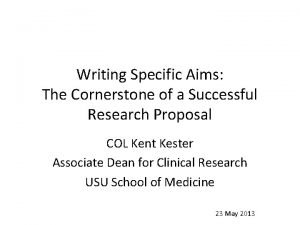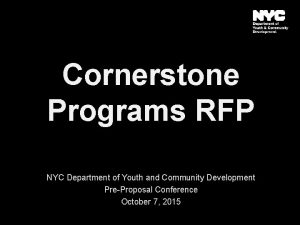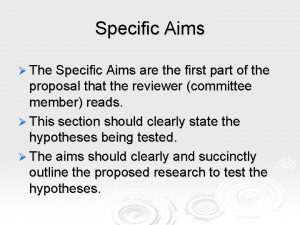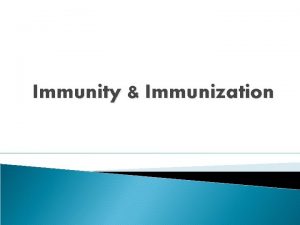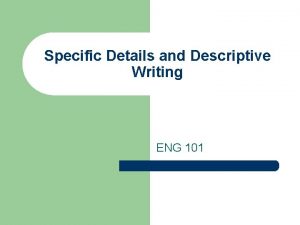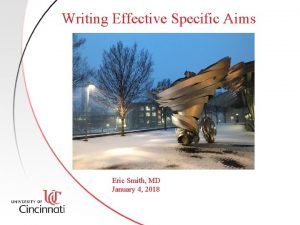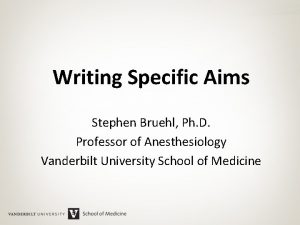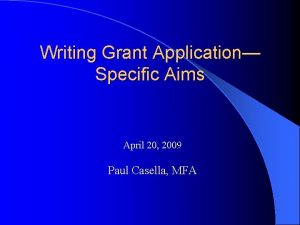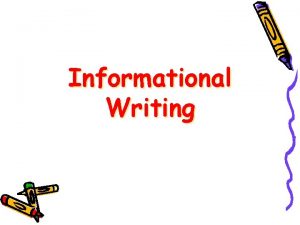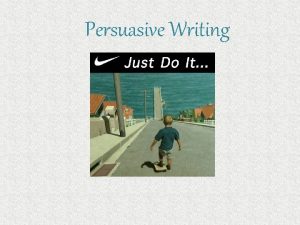Writing Specific Aims The Cornerstone of a Successful







































- Slides: 39

Writing Specific Aims: The Cornerstone of a Successful Research Proposal COL Kent Kester Associate Dean for Clinical Research USU School of Medicine 23 May 2013

What you should learn from this session • The importance and centrality of the Specific Aims section of a research proposal • How the Specific Aims section fits in to the larger research proposal and its development • To see some examples of successful Specific Aims submitted as part of research grant proposals

Getting Research Grants Funded • Good Science – Hypothesis – Approach • Good Marketing – Well-written proposal responsive to the program instructions SALES!!!

Steps associated with the NIH grant application process Berg, KM, et al. J Gen Int Med 2007; 22: 1587 -95

Grant-writing timeline Inouye, SK, et al. Ann Intern Med 2005; 142: 274 -282

Grant-Execution Timeline Inouye, SK, et al. Ann Intern Med 2005; 142: 274 -282

Common Reasons for unfunded proposals • Lack of new ideas • Unfocused research plan: poorly-written or unresponsive to program directions • Lack on knowledge of published relevant work • Lack of essential scientific experience • Future directions of research? • Questionable experimental approach • Unrealistic scope of work • Lack of experimental detail • Limited funding: major issue at present – FY 13: NIAID R 01 new investigator 12%; established investigator 8%

Define your goals • Specific • Measurable • Realistic

Specific Aims: The Cornerstone of the entire research proposal • What do you want to accomplish (objectives)? – This is the master plan for your research. – Not unusual for some members of the study section to read only the Specific Aims and Project Summary/Abstract before scoring. • Dense, full-of-jargon, poorly-written Specific Aims will not help the scoring of your proposal, even if the science is sound! – Is a useful summary for obtaining early feedback on your proposal • Includes project milestones, hypotheses to be tested—all the key aspects of your project (e. g. , what is important and exciting) without fine detail • Aim for an unmet scientific need • Be crystal-clear in your writing! – You provide the conceptual framework upon which the reviewers hang the details of what will be done.

Funding Sources NIH/AHRQ • • • R 01 Research Project Grant R 03 Small Grant Program R 15 Academic Research Enhancement Award R 21 Exploratory Research Grant U 01 Research Project Cooperative Agreement K 99/R 00 Pathway to Independence Award Other Federal Sources • Do. D: MRMC, DHP, MILVAX, DTRA, DARPA – Infectious Disease, Combat Casualty Care, Military Operational Medicine, Regenerative Medicine, etc. • • • CDC DVA Others: USDA, USAID, FDA, etc. Foundations/Nonprofits • • Gates Foundation Disease-specific foundations Industry • • Research or clinical trials support CRADAs, grants, or in-kind funding In many cases, the standard NIH format for organization of your grant proposal is often preferred. Read the submission instructions!

Specific Aims: Often the Hardest Part of the Proposal to Write • The most important part of your proposal—you have to “SELL” your research idea! – Understand your customer (e. g. , Study Section reviewers) – Show that you will help NIH (or Do. D, DVA, etc. ) accomplish its goals • Start with a concise problem statement and state why it is important • Limit yourself to 2 -4 aims • Be declarative • Make sure to explain why the research matters • Final product: A well-crafted project that will result in the advancement of significant knowledge in your field

Know Your Audience • Align your project with defined research priorities – Particularly relevant to Do. D-funded medical research (e. g. , what is really important to the Do. D? ) • Identify who will be reviewing your proposal – http: //public. csr. nih. gov/Study. Sections/Pages/default. aspx • Know the evaluation criteria – NIH: significance, investigator, innovation, approach, environment – Others: Find Out if not specified (= do your homework!)

First Impressions of Your Proposal • Title • Abstract: the movie poster • Specific Aims: the movie trailer

Themes for Specific Aims • Convince the reviewers that the funding will be a good return on investment (SALES) • Write for a general science audience; don’t bury your aims in too much jargon • Explain specialized terminology – Too dense to read = too dense to fund • Keep it general and interesting – Focus on Why, Who, What, and How

NIH Research Project Grant Review Criteria • • • Significance: is the work important? Innovation: is it new thinking? Approach: is it feasible? Investigator(s): are they well-suited? Environment: is there adequate support and resources?



It is essential to start with a good question. • What is the mechanism of X? • Is this drug/vaccine/diagnostic device better than the current standard? • Does this new curriculum result in enhanced learning? • Does this change in clinical practice improve clinical outcomes?

The best research questions have significance and impact. • Does the project address an important problem (knowledge gap)? – Novel antiviral drug: new mechanism of action – Identification of previously-unrecognized pathway for viral or parasite development in insect vectors prior to transmission to humans • If the goals of the project are achieved – How will scientific knowledge or clinical practice be improved? – How will the field be changed?

Proposal should be based on a hypothesis Hypothesis: a general statement, based on existing information, that describes a process in nature – Allows one to make specific predictions that can be tested experimentally Properties: – Fit: compatible with existing knowledge – Testability – Simplicity – Generality: applies broadly

Elements of a Specific Aims Page • Concise statement of the goals of the proposed research and a summary of the expected outcomes, including impact on the field • List the specific objectives of the research: – Test a hypothesis – Create a novel design – Solve a specific problem – Challenge an existing paradigm or clinical practice – Address a critical barrier to progress in the field – Develop new technology

A good format for a Specific Aims Section is a sandwich • First section: topic, goals, objectives, hypothesis, and rationale • Specific Aims: objectives and description – HEADLINES • Last paragraph: impact and outcomes • Consider use of visual models in order to communicate a complex subject.

Writing Specific Aims • Create a bullet outline • Consider organizing bullets within four distinct paragraphs: – Introductory paragraph – What, Why, Who paragraph – Specific Aims paragraph – Payoff paragraph: helps to develop advocacy for your proposal among the majority of reviewers who will not, in all likelihood, have read the complete application • There should be at least one important expected outcome for each of your aims.

First paragraph: provides the rationale for the proposed study(ies) • What is the Topic? – Opening sentence needs to be interest-grabbing. • Statement of current knowledge: will help less-expert panel members get up to speed with respect to what is know about the topic of the application • What is the Gap in knowledge? – The gap in knowledge is what is holding back the field and is what you will address in the application. • What is the long-term Goal of your research? • What are the specific Objectives for the proposal? • What is the Hypothesis? • What is the evidence for the hypothesis? • What is the Rationale/Significance? GOAL: half-page or less (~300 words) to set the stage and to interest the reviewer

Start the Specific Aims with a concise, active statement introducing the topic of the proposal • In sub-Saharan Africa, co-infection with HIV worsens clinical malaria and has resulted in an additional 3 million cases of clinical malaria and 65, 000 deaths. • Diabetes is a major health concern in the U. S. • Molecular analysis has emerged as one of the most powerful tools to determine antimicrobial resistance mechanisms

Describe the gap in knowledge or unmet need that the proposal will address • There is a critical gap in our knowledge about the impact of HIV on asymptomatic malaria and how HIV may impact the ability of adults to serve as efficient reservoirs of disease. • But the incidence of diabetes continues to rise. • Management of parasitic diseases depends largely on chemotherapy but anti-parasitic drug treatments has multiple challenges.

Describe your goals • Our long-term goal is to understand how behavioral modification can prevent the early onset of diabetes. • The goal of our research is to determine the mechanism of X (or Y, or Z). • The overall goal of our research group is to define the role of …

Describe the specific objectives • We propose to focus a series of complementary clinical and entomological studies using highly sensitive and specific molecular tools in a highly endemic area of western Kenya to address… • This proposal will focus on testing behavioral interventions in the institutionalized elderly. • We propose to develop artificial intelligence algorithms for the analysis of thought-related changes in cerebral perfusion.

Define the underlying hypothesis • We hypothesize that HIV itself, and the treatment used routinely for opportunistic infection prophylaxis, contribute to excess malaria burden by increasing the prevalence of asymptomatic adult reservoirs that experience frequent and prolonged periods of transmissible sub-microscopic gametocytema. • Both of these responses are unique to a subset of enterococci exhibiting the Van-A phenotype, and we hypothesize that they are essential for the pathogenesis of…

Describe the evidence for the hypothesis • For the first time, our published data from macaques support a direct enhancing effect of retrovirus preinfection on malaria parasite growth, gametocytogenesis, and transmission. • Prior studies conducted by our group have demonstrated novel interactions between unbound phenytoin and coronary endothelial cells.

Each specific aim has a short descriptive title and brief description • Aim 1: To determine the pathogenesis of the disease in vivo – Based on our hypothesis, we predict that disruption of the interaction between XYZ and the ABC receptor will increase resistance to the disease a. Assess disease pathogenesis in mice with mutations in XYZ or the ABC receptor b. Assess disease resistance in mice treated with si. RNA directed toward XYZ or the ABC receptor

Specific Aim Examples • Aim 1: Point prevalence of co-infection – We will determine whether the prevalence and magnitude of peripheral parasitemia, and specifically gametocytemia, are greater in untreated HIV-positive adults than in HIV-negative adults. These data will reveal whether untreated HIV-infected persons are, in fact, more efficient reservoirs of malaria. • Aim 2: Longitudinal prevalence of asymptomatic parasitemia – We will compare the incidence, intensity, and duration of asymptomatic malaria parasitemia in general, and gametocytemia specifically, in HIV-negative adults, in HIV-positive adults on TS only, and in HIV-positive adults on TS plus ART. We will measure the impact of prolonged TS therapy on gametocyte carriage.

The last paragraph focuses on innovation, impact, and outcomes • Innovation: – To our knowledge, this proposal is the first attempt to use microarray technology to discern differential patterns in human gene activation associated with experimental malaria infection – This proposal applies two state-of-the-art techniques to understand the pathogenesis of sarcoidosis. – Note that innovation doesn’t always mean the use of the latest molecular biology tools and techniques. • Outcomes and Impact: – The experiments described in this proposal will provide a complete description of the mechanism… – Understanding the pathogenesis of this disease will lead to new therapeutic approaches.

Additional Details • Make sure that research proposal is properly aligned with the funding program (= read the directions) • Get feedback! • Make sure that there are no stray regulatory compliance issues (like human subjects or animal welfare). Ignoring these aspects can doom your proposal.


http: //projectreporter. nih. gov/reporter. cfm

Some final thoughts • Lay out your aims so clearly so that the reviewers understand them without having to read things more than once. • Lead the reviewer down a logical trail of ideas that makes the conclusion of what is being proposed to be done is inescapable. One can include a relevant quotation from the NIH Director or an excerpt from an NIH strategic research plan). • Pique the reviewer’s interest—help them share your sense that there is an important mystery to be solved.

And remember… • No amount of flowery language will overcome a skeptical audience. – Propose good science – Write well – Follow the directions – Get feedback

References Inouye SK, Fiellin DA. An evidence-based guide to writing grant proposals for clinical research. Annals of Internal Medicine 2005; 142: 274 -282. Berg KM, Gill TM, Brown AF, et al. Demystifying the NIH grant application process. Journal of General Internal Medicine 2007; 22(11): 15871595.
 Good specific aims examples
Good specific aims examples Cornerstone bible institute
Cornerstone bible institute The chief cornerstone high school
The chief cornerstone high school Is a cornerstone in the protection of information assets
Is a cornerstone in the protection of information assets I rest on his unchanging grace
I rest on his unchanging grace Define chief cornerstone
Define chief cornerstone Cornerstone big data
Cornerstone big data Cornerstone employer
Cornerstone employer Cornerstone charter academy bell schedule
Cornerstone charter academy bell schedule Identify the cornerstones of the wellness movement
Identify the cornerstones of the wellness movement Cornerstone
Cornerstone Lesson 1 american free enterprise capitalism answers
Lesson 1 american free enterprise capitalism answers Cornerstone congregational church
Cornerstone congregational church Cornerstone deployment
Cornerstone deployment Specific gravity of syrup
Specific gravity of syrup Plummet method
Plummet method What are the advantages and disadvantages of essay writing
What are the advantages and disadvantages of essay writing What are the objectives of summary writing
What are the objectives of summary writing Hát kết hợp bộ gõ cơ thể
Hát kết hợp bộ gõ cơ thể Ng-html
Ng-html Bổ thể
Bổ thể Tỉ lệ cơ thể trẻ em
Tỉ lệ cơ thể trẻ em Chó sói
Chó sói Tư thế worms-breton
Tư thế worms-breton Chúa sống lại
Chúa sống lại Môn thể thao bắt đầu bằng từ chạy
Môn thể thao bắt đầu bằng từ chạy Thế nào là hệ số cao nhất
Thế nào là hệ số cao nhất Các châu lục và đại dương trên thế giới
Các châu lục và đại dương trên thế giới Công thức tính độ biến thiên đông lượng
Công thức tính độ biến thiên đông lượng Trời xanh đây là của chúng ta thể thơ
Trời xanh đây là của chúng ta thể thơ Mật thư tọa độ 5x5
Mật thư tọa độ 5x5 Làm thế nào để 102-1=99
Làm thế nào để 102-1=99 Phản ứng thế ankan
Phản ứng thế ankan Các châu lục và đại dương trên thế giới
Các châu lục và đại dương trên thế giới Thể thơ truyền thống
Thể thơ truyền thống Quá trình desamine hóa có thể tạo ra
Quá trình desamine hóa có thể tạo ra Một số thể thơ truyền thống
Một số thể thơ truyền thống Bàn tay mà dây bẩn
Bàn tay mà dây bẩn Vẽ hình chiếu vuông góc của vật thể sau
Vẽ hình chiếu vuông góc của vật thể sau Nguyên nhân của sự mỏi cơ sinh 8
Nguyên nhân của sự mỏi cơ sinh 8
